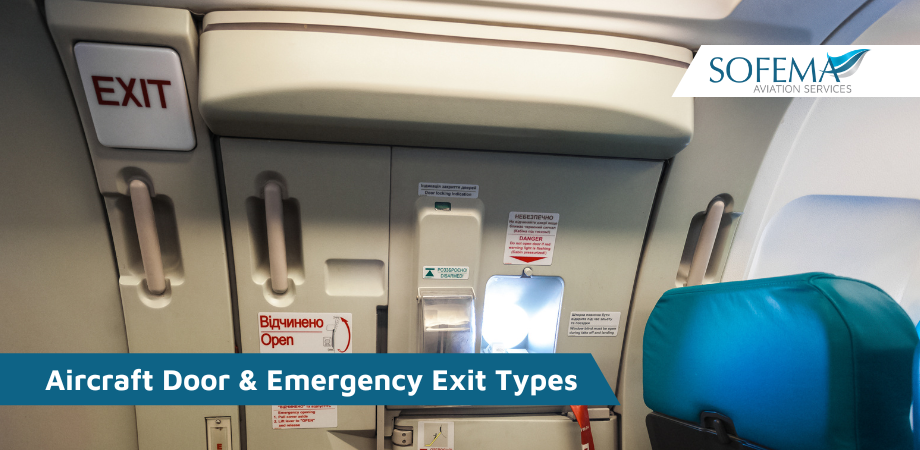Sofema Aviation Services (SAS) www.sassofia.com considers the different types of Exit & Emergency Exit in use in Commercial Aircraft.
- Aircraft Exit Doors types & Location
- Aircraft Exit Doors Size Details
Type I. This type is a floor-level exit with a rectangular opening of not less than 24 inches wide by 48 inches high, with corner radii not greater than eight inches.
Type II. This type is a rectangular opening of not less than 20 inches wide by 44 inches high, with corner radii not greater than seven inches.
- Type II exits must be floor-level exits unless located over the wing, in which case they must not have a step-up inside the airplane of more than 10 inches nor a step-down outside the airplane of more than 17 inches.
Type III. This type is a rectangular opening of not less than 20 inches wide by 36 inches high with corner radii not greater than seven inches, and with a step-up inside the airplane of not more than 20 inches.
- If the exit is located over the wing, the step-down outside the airplane may not exceed 27 inches.
Type IV. This type is a rectangular opening of not less than 19 inches wide by 26 inches high, with corner radii not greater than 6.3 inches, located over the wing, with a step-up inside the airplane of not more than 29 inches and a step-down outside the airplane of not more than 36 inches.
Ventral. This type is an exit from the passenger compartment through the pressure shell and the bottom fuselage skin.
- The dimensions and physical configuration of this type of exit must allow at least the same rate of egress as a Type I exit with the airplane in the normal ground attitude, with landing gear extended.
Tailcone. This type is an aft exit from the passenger compartment through the pressure shell and through an openable cone of the fuselage aft of the pressure shell.
- The means of opening the tail cone must be simple and obvious and must employ a single operation.
Type A. This type is a floor-level exit with a rectangular opening of not less than 42 inches wide by 72 inches high, with corner radii not greater than seven inches.
Type B. This type is a floor-level exit with a rectangular opening of not less than 32 inches wide by 72 inches high, with corner radii not greater than six inches.
Type C. This type is a floor-level exit with a rectangular opening of not less than 30 inches wide by 48 inches high, with corner radii not greater than 10 inches.
Definitions
Step Down Distance – Step down distance, as used in this section, means the actual distance between the bottom of the required opening and a usable foot hold, extending out from the fuselage, that is large enough to be effective without searching by sight or feel.
Over-sized exits – Openings larger than those specified in this section, whether or not of rectangular shape, may be used if the specified rectangular opening can be inscribed within the opening and the base of the inscribed rectangular opening meets the specified step-up and step-down heights.
Asymmetry – Exits of an exit pair need not be diametrically opposite each other nor of the same size; however, the number of passenger seats permitted based on the smaller of the two exits.
Uniformity – Exits must be distributed as uniformly as practical, taking into account passenger seat distribution.
Location
- Each required passenger emergency exit must be accessible to the passengers and located where it will afford the most effective means of passenger evacuation.
- If only one floor-level exit per side is prescribed, and the airplane does not have a tail cone or ventral emergency exit, the floor-level exits must be in the rearward part of the passenger compartment unless another location affords a more effective means of passenger evacuation.
- If more than one floor-level exit per side is prescribed, and the airplane does not have a combination cargo and passenger configuration, at least one floor-level exit must be located in each side near each end of the cabin.
Note – For an airplane that is required to have more than one passenger emergency exit for each side of the fuselage, no passenger emergency exit shall be more than 60 feet from any adjacent passenger emergency exit on the same side of the same deck of the fuselage, as measured parallel to the airplane’s longitudinal axis between the nearest exit edges.
Type and number required
The maximum number of passenger seats permitted depends on the type and number of exits installed on each side of the fuselage.
The maximum number of passenger seats permitted for each exit of a specific type installed on each side of the fuselage is as follows:
- Type A – 110
- Type B – 75
- Type C – 55
- Type I – 45
- Type II – 40
- Type III – 35
- Type IV – 9
Next Steps
Follow this link to our Library to find & Download related documents for Free.
Sofema Aviation Services (SAS) Provides Consultancy, Classroom, Webinar, and Online Training including the following course: EASA CS 25 Compliant Cabin Certification & Mods Training Program – 5 Days
Please see our websites www.sassofia.com and www.sofemaonline.com or email team@sassofia.com for additional details regarding our training options.
Tags:
aviation, SAS blogs, CS 25, EASA CS-25, Cabin Certification, Emergency Exit, Aircraft Door, Commercial Aircraft, Cabin Certification and Mods





